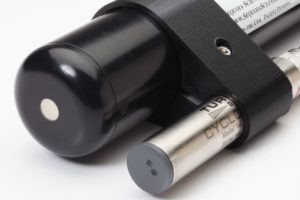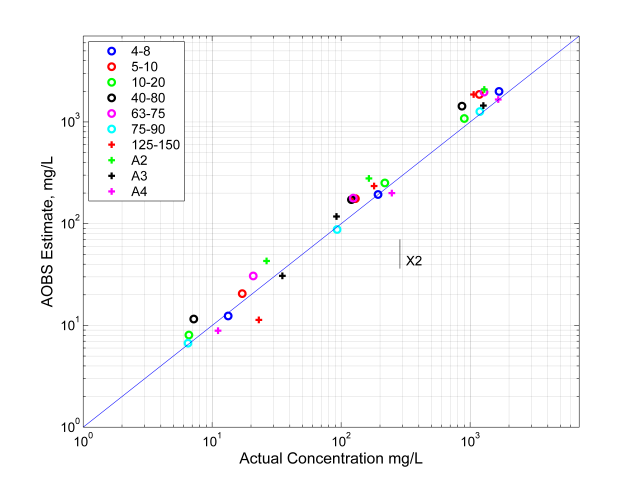LISST-AOBS has Nearly Uniform Sensitivity Across Wide Grain Sizes!
B
Why the Acousto-Optic Super-Turbidity Sensor LISST-AOBS?

- The sensitivity (Volts/[mg/L] ) of Optical turbidity sensors varies inversely with grain size. Turbidity sensors are highly sensitive to fine particles, and insensitive to large particles.
- The LISST-ABS has a nearly constant sensitivity (Volts/Concentration) for particles larger than about 30 microns, out to about 500 microns. But, below this range, the response is also size dependent. These sensors are highly insensitive to fine particles, and sensitive to large particles – the opposite of optical turbidity.
- The combination, done properly, compensates these opposite tendencies of change with grain size, and produces a system that is substantially (but not totally) independent of grain size in this range. (See below)
What are the benefits?
- Because of a near-constant calibration for the combined turbidity – LISST-ABS, measurements are far more accurate, over a wide grain size range, than either technology.
- Due to size dependence, individual calibration of the turbidity and LISST-ABS sensors is normally required, when operating alone. But, because of the fixed calibration achieved by the combination of ‘paired’ LISST-ABS and turbidity sensors, the need for calibration of either sensor is greatly reduced. This is a major convenience to experimentalists!
Can I combine past data that I already have?
- YES! A single calibration step finds a critical weight factor that then is used to combine past data. The step involves obtaining one measurement of sensitivity of the optical turbidity sensor at a given grain size (30 microns). A weight factor is found as the ratio of LISST-ABS output and turbidity sensor output. This weight factor then allows the weighted sum of the two instrument outputs, thus correcting past data also.
How does it work?
- From the calibration of the turbidity, the response (Volts/[g/L]) is measured for 30 micron particles. A weight factor is computed using this value [method for computation is to be provided]. The two outputs – LISST-ABS and turbidity – are combined with this weight factor applied to the turbidity data. The figure below shows the sensitivity of the optical turbidity and LISST-ABS, working alone, and after weighted addition.
How well does it work?
The figure below shows the sensitivity of a LISST-ABS and a turbidity sensor for a wide range of narrow grain sizes (in legend) and powders from Particle Technology, Inc. of Colorado. Combining the two produces the AOBS output. Not perfect, but is it substantially improved over either technology. If not combined, the individual technologies produce errors of a factor of ~100.

LISST-AOBS
When will the LISST-AOBS be available?
Check here.